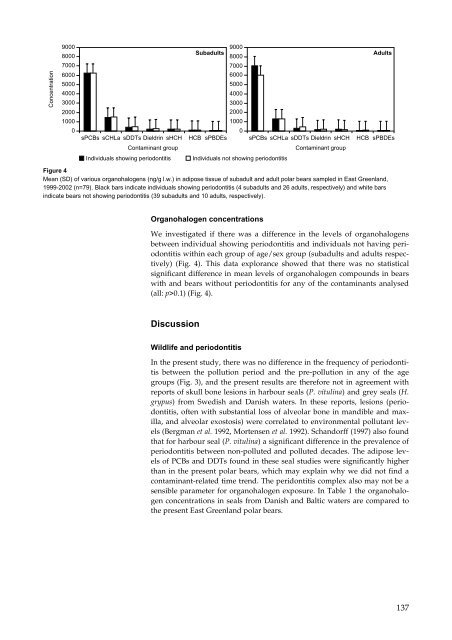Organohalogen concentrations and a gross and histologic ...
Organohalogen concentrations and a gross and histologic ...
Organohalogen concentrations and a gross and histologic ...
You also want an ePaper? Increase the reach of your titles
YUMPU automatically turns print PDFs into web optimized ePapers that Google loves.
Concentration<br />
9000<br />
8000<br />
7000<br />
6000<br />
5000<br />
4000<br />
3000<br />
2000<br />
1000<br />
0<br />
9000<br />
Subadults<br />
8000<br />
7000<br />
6000<br />
5000<br />
4000<br />
3000<br />
2000<br />
1000<br />
0<br />
Adults<br />
sPCBs sCHLa sDDTs Dieldrin sHCH HCB sPBDEs sPCBs sCHLa sDDTs Dieldrin sHCH HCB sPBDEs<br />
Contaminant group Contaminant group<br />
Individuals showing periodontitis Individuals not showing periodontitis<br />
Figure 4<br />
Mean (SD) of various organohalogens (ng/g l.w.) in adipose tissue of subadult <strong>and</strong> adult polar bears sampled in East Greenl<strong>and</strong>,<br />
1999-2002 (n=79). Black bars indicate individuals showing periodontitis (4 subadults <strong>and</strong> 26 adults, respectively) <strong>and</strong> white bars<br />
indicate bears not showing periodontitis (39 subadults <strong>and</strong> 10 adults, respectively).<br />
<strong>Organohalogen</strong> <strong>concentrations</strong><br />
We investigated if there was a difference in the levels of organohalogens<br />
between individual showing periodontitis <strong>and</strong> individuals not having periodontitis<br />
within each group of age/sex group (subadults <strong>and</strong> adults respectively)<br />
(Fig. 4). This data explorance showed that there was no statistical<br />
significant difference in mean levels of organohalogen compounds in bears<br />
with <strong>and</strong> bears without periodontitis for any of the contaminants analysed<br />
(all: p>0.1) (Fig. 4).<br />
Discussion<br />
Wildlife <strong>and</strong> periodontitis<br />
In the present study, there was no difference in the frequency of periodontitis<br />
between the pollution period <strong>and</strong> the pre-pollution in any of the age<br />
groups (Fig. 3), <strong>and</strong> the present results are therefore not in agreement with<br />
reports of skull bone lesions in harbour seals (P. vitulina) <strong>and</strong> grey seals (H.<br />
grypus) from Swedish <strong>and</strong> Danish waters. In these reports, lesions (periodontitis,<br />
often with substantial loss of alveolar bone in m<strong>and</strong>ible <strong>and</strong> maxilla,<br />
<strong>and</strong> alveolar exostosis) were correlated to environmental pollutant levels<br />
(Bergman et al. 1992, Mortensen et al. 1992). Sch<strong>and</strong>orff (1997) also found<br />
that for harbour seal (P. vitulina) a significant difference in the prevalence of<br />
periodontitis between non-polluted <strong>and</strong> polluted decades. The adipose levels<br />
of PCBs <strong>and</strong> DDTs found in these seal studies were significantly higher<br />
than in the present polar bears, which may explain why we did not find a<br />
contaminant-related time trend. The peridontitis complex also may not be a<br />
sensible parameter for organohalogen exposure. In Table 1 the organohalogen<br />
<strong>concentrations</strong> in seals from Danish <strong>and</strong> Baltic waters are compared to<br />
the present East Greenl<strong>and</strong> polar bears.<br />
137

















